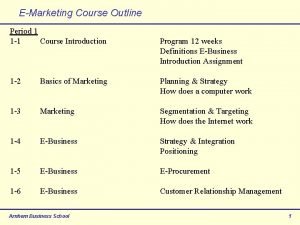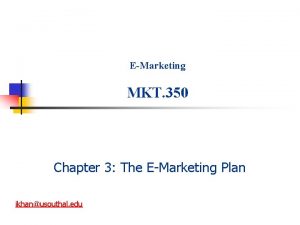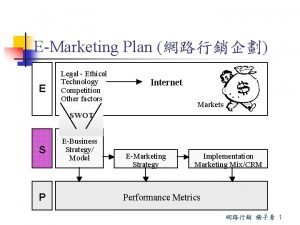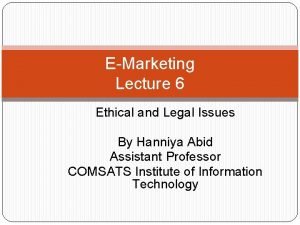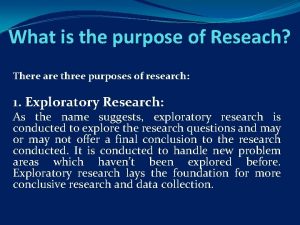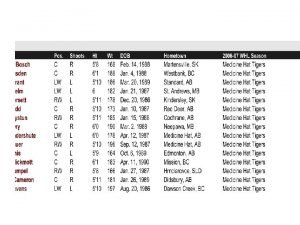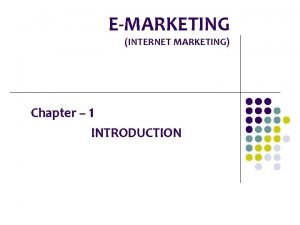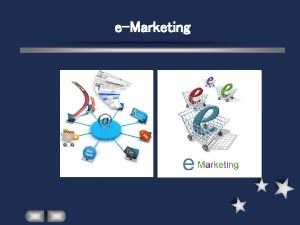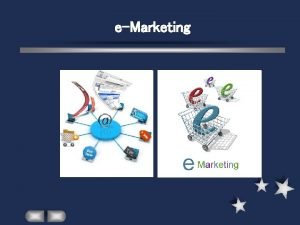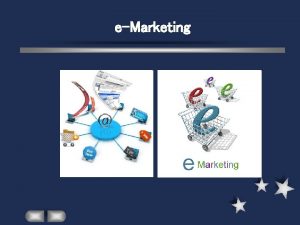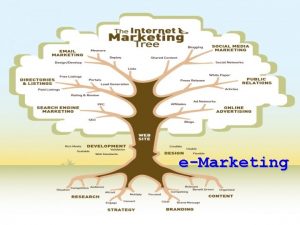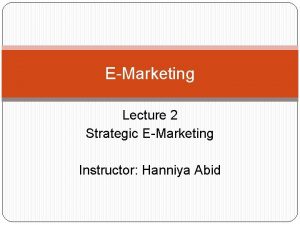EMarketing6 E Chapter 6 EMarketing Research Chapter 6



































- Slides: 35

E-Marketing/6 E Chapter 6 E-Marketing Research

Chapter 6 Objectives After reading Chapter 6, you will be able to: Identify the three main sources of data that emarketers use to address research problems. Discuss how and why e-marketers need to check the quality of research data gathered online. Explain why the Internet is used as a contact method for primary research and describe the main Internet-based approaches to primary research. © 2014 PEARSON EDUCATION, INC. PUBLISHING AS PRENTICE HALL 2

Chapter 6 Objectives (Cont. ) Describe several ways to monitor the web for gathering desired information. Contrast client-side, server-side, and real-space approaches to data collection. Explain the concepts of big data and cloud computing. Highlight four important methods of analysis that e -marketers can apply to data warehouse information. © 2014 PEARSON EDUCATION, INC. PUBLISHING AS PRENTICE HALL 3

The Purina Story Nestle Purina Pet. Care wanted to know whether their websites and online advertising increased off-line behavior. http: //www. purina. com Nestle Purina developed 3 research questions: Are our buyers using our branded websites? Should we invest beyond these branded Web sites in online advertising? If so, where should we place the advertising? © 2014 PEARSON EDUCATION, INC. PUBLISHING AS PRENTICE HALL 4

The Purina Story, Cont. Combined online and off-line shopping panel data revealed: Banner click-through rate was low (0. 06%). 31% of subjects exposed to Purina ads mentioned the Purina brand compared with 22% of the no-exposure subjects. Home/health and living sites received the most visits from their customers. The information helped the firm decide where to place banner ads. © 2014 PEARSON EDUCATION, INC. PUBLISHING AS PRENTICE HALL 5


Data Drive Strategy U. S. marketers spend $6. 7 B annually on marketing research; global spend is $18. 9 B. E-marketers can generate a great deal of data by using surveys, Web analytics, secondary data, social media conversations, etc. Marketing insight occurs somewhere between information and knowledge. Data without insight or application to inform marketing strategy are worthless. Purina, for example, sorts through hundreds of millions of pieces of data about 21. 5 million consumers to make decisions. © 2014 PEARSON EDUCATION, INC. PUBLISHING AS PRENTICE HALL 7

Big Data Big data refers to huge data sets that are difficult to manage and analyze. 31% of marketers would like to collect Web data daily. 74% collect demographic data; 64% collect transaction data; 35% monitor social media. Purina, for example, sorts through hundreds of millions of pieces of data from about 21. 5 million consumers to make marketing decisions. © 2014 PEARSON EDUCATION, INC. PUBLISHING AS PRENTICE HALL 6 -8

From Data to Decision: Nestle Purina © 2014 PEARSON EDUCATION, INC. PUBLISHING AS PRENTICE HALL 9

Marketing Knowledge Management Knowledge management is the process of managing the creation, use, and dissemination of knowledge. Data, information, and knowledge are shared with internal decision makers, partners, channel members, and sometimes customers. A marketing knowledge database includes data about customers, prospects and competitors. © 2014 PEARSON EDUCATION, INC. PUBLISHING AS PRENTICE HALL 10

The Electronic MIS A marketing information system (MIS) is the process by which marketers manage knowledge. Many firms store data in databases and data warehouses, available 24/7 to e-marketers. The Internet and other technologies facilitate data collection. Secondary data provide information about competitors, consumers, the economic environment, etc. Marketers use the internet and other technologies to collect primary data about consumers. © 2014 PEARSON EDUCATION, INC. PUBLISHING AS PRENTICE HALL 11

Most Common Data Collection Methods © 2014 PEARSON EDUCATION, INC. PUBLISHING AS PRENTICE HALL 12

SOURCE 1: INTERNAL RECORDS Accounting, finance, production, and marketing personnel collect and analyze data for marketing planning. Sales data Customer characteristics and behavior Universal product codes (UPCs) Tracking of user movements through web pages Web sites visited before and after the firm’s Web site. © 2014 PEARSON EDUCATION, INC. PUBLISHING AS PRENTICE HALL 13

SOURCE 2: SECONDARY DATA Can be collected more quickly and less expensively than primary data. Secondary data may not meet e-marketer’s information needs. Data was gathered for a different purpose. Quality of secondary data may be unknown. Data may be old. Marketers continually scan the macroenvironment for threats and opportunities, a procedure commonly called business intelligence. © 2014 PEARSON EDUCATION, INC. PUBLISHING AS PRENTICE HALL 14

Public & Private Data Sources Publicly generated data Privately generated data U. S. Patent Office com. Score CIA World Factbook Forrester Research American Marketing Nielsen/Net. Ratings Association (AMA) Wikipedia Ministry of Economy Commercial online databases Euro monitor (http: //www. euromonitor. com) and Planning (www. mep. gov. sa) The Patent Office of the Cooperation Council for the Arab States of the Gulf (http: //www. gccpo. org/) © 2014 PEARSON EDUCATION, INC. PUBLISHING AS PRENTICE HALL 15

Competitive Intelligence Example CI involves analyzing the industries in which a firm operates as input to the firm’s strategic positioning and to understand competitor weaknesses. CI can help firm’s analyze competition as well as assist in strategic planning Intelligence cycles would include the following steps: 1. Define the intelligence requirements 2. Collect and organize information 3. Analyze by applying information to the specific purpose and recommending action 4. Report and inform others of the finding 5. Evaluate the impact of intelligence use and suggest process improvements © 2014 PEARSON EDUCATION, INC. PUBLISHING AS PRENTICE HALL 16

Competitive Intelligence Example (Cont. ) Sources may include press releases, new products, alliances and co-brands, trade shows third-party, industry-specific sites user conversation in the social media Facebook. © 2014 PEARSON EDUCATION, INC. PUBLISHING AS PRENTICE HALL 17

Information Quality Secondary and primary sources have many limitations. E-marketers should be wary of data, especially if it is secondary data. E-marketers should: Discover the website’s author, Try to determine if the site author is an authority on the Web site topic, Check to see when the site was last updated, Determine how comprehensive the site is, Try to validate the research data by finding similar information at other sources on the internet or in hard copy at the library, and Check the site content for accuracy. What about Wikipedia, is it accurate? © 2014 PEARSON EDUCATION, INC. PUBLISHING AS PRENTICE HALL 18

Source 3: Primary Data When secondary data are not available, marketers may collect their own information. Primary data are information gathered for the first time to solve a particular problem. More expensive and time consuming Current, more relevant & exclusive Primary data collection can be enhanced by the internet: Online experiments Online focus groups Online observation Content analysis Online survey research © 2014 PEARSON EDUCATION, INC. PUBLISHING AS PRENTICE HALL 19

Primary Research Steps The steps to conduct primary research are: 1. Define the research problem, 2. Develop a research plan, Research approach Sample design Contact method Instrument design Collect data, 4. Analyze the data, and 5. Distribute results 3. © 2014 PEARSON EDUCATION, INC. PUBLISHING AS PRENTICE HALL 20

Typical Research problems for EMarketers © 2014 PEARSON EDUCATION, INC. PUBLISHING AS PRENTICE HALL 21

Source 3: Primary Data Collection Methods In-depth interviews (IDI) are better done offline Primary data collection enhanced by the Internet Online experiments Online focus groups Online observation Online survey research Web surveys Online panels © 2014 PEARSON EDUCATION, INC. PUBLISHING AS PRENTICE HALL 22

Advantages & disadvantages of online survey research © 2014 PEARSON EDUCATION, INC. PUBLISHING AS PRENTICE HALL 23

Online Panels Online panels include people who have agreed to be subjects of marketing research. Participants are usually paid and often receive free products. Panels can help combat sampling and response problems, but can be more expensive than traditional methods of sample generation. © 2014 PEARSON EDUCATION, INC. PUBLISHING AS PRENTICE HALL 6 -24

Ethics of Online Research Companies conducting research on the web often give respondents a gift or fee for participating. Other ethical concerns include: Respondents are increasingly upset at getting unwelcomed e-mail requests for survey participation. “Harvesting” of e-mail addresses from newsgroups without permission. “Surveys” used to build a database. Privacy of user data. © 2014 PEARSON EDUCATION, INC. PUBLISHING AS PRENTICE HALL 25

Other Technology-Enabled Approaches Client-side Data Collection Cookies PC meter with panel of users to track the user clickstream. Server-side Data Collection Site log software can generate reports on number of users who view each page, location of prior site visited, etc. Real-time profiling tracks users’ movements through a website. © 2014 PEARSON EDUCATION, INC. PUBLISHING AS PRENTICE HALL 26

Following the clickstream at FTC. gov © 2014 PEARSON EDUCATION, INC. PUBLISHING AS PRENTICE HALL 27

Real-Space Approaches Real-space primary data collection: technology enabled approaches to gather information offline. Data collection occurs at off-line points of purchase and information is stored and used in marketing databases. Real-space techniques include bar code scanners and credit card terminals. Catalina Marketing uses the Universal Product Code (UPC) for promotional purposes at grocery stores. © 2014 PEARSON EDUCATION, INC. PUBLISHING AS PRENTICE HALL 28

REAL-SPACE DATA COLLECTION & STORAGE EXAMPLE © 2014 PEARSON EDUCATION, INC. PUBLISHING AS PRENTICE HALL 29

Marketing Databases & Data Warehouses Product databases hold information about product features, prices, and inventory levels; customer databases hold information about customer characteristics and behaviors. Data warehouses are storehouses for the entire organization’s historical data, not just for marketing data. Software vendors are attempting to solve the website maintenance problem with content management systems. The current trend in data storage is toward cloud computing: a network of online Web servers used to store and manage data. © 2014 PEARSON EDUCATION, INC. PUBLISHING AS PRENTICE HALL 30

Cloud Computing Mobile phone Tablet computer Remote servers Data content Computer © 2014 PEARSON EDUCATION, INC. PUBLISHING AS PRENTICE HALL Company Web server 31

Data Analysis & Distribution Four important types of analysis for marketing decision making include: Data mining Customer profiling RFM (recency, frequency, monetary value) analysis Report generating © 2014 PEARSON EDUCATION, INC. PUBLISHING AS PRENTICE HALL 32

Knowledge Management Metrics Two metrics are currently in widespread use for online data storage: ROI: total cost savings divided by total cost of the installation. Total Cost of Ownership (TCO): includes cost of hardware, software, labor, and cost savings. © 2014 PEARSON EDUCATION, INC. PUBLISHING AS PRENTICE HALL 33


All rights reserved. No part of this publication may be reproduced, stored in a retrieval system, or transmitted, in any form or by any means, electronic, mechanical, photocopying, recording, or otherwise, without the prior written permission of the publisher. Printed in the United States of America. Copyright © 2014 Pearson Education, Inc. Publishing as Prentice Hall © 2014 PEARSON EDUCATION, INC. PUBLISHING AS PRENTICE HALL 6 -35
 E marketing planning
E marketing planning Emarketing system
Emarketing system Plan emarketing
Plan emarketing 6 i's of e marketing
6 i's of e marketing Cours emarketing
Cours emarketing Emarketing plan
Emarketing plan Plan emarketing
Plan emarketing Legal emarketing
Legal emarketing Legal emarketing
Legal emarketing Research report vs research proposal
Research report vs research proposal Methodology vs method
Methodology vs method Appendix in quantitative research
Appendix in quantitative research Distinguish between exploratory and conclusive research
Distinguish between exploratory and conclusive research What is applied research
What is applied research Theoretical background example
Theoretical background example Contrast applied research and basic research
Contrast applied research and basic research Rephrasing the research problem
Rephrasing the research problem Research paradigm example
Research paradigm example Operational thought
Operational thought Correlational research
Correlational research Chapter 3: research methodology
Chapter 3: research methodology Applied vs fundamental research
Applied vs fundamental research Basic research vs applied research
Basic research vs applied research Define reseach
Define reseach Research qualitative or quantitative
Research qualitative or quantitative Practical research 2 nature of inquiry and research
Practical research 2 nature of inquiry and research Exploratory research vs conclusive research
Exploratory research vs conclusive research The major emphasis in exploratory research is on
The major emphasis in exploratory research is on Objectives of research example
Objectives of research example Research instrument in experimental research
Research instrument in experimental research Eight characteristics educational research
Eight characteristics educational research Findings of qualitative research
Findings of qualitative research Experimental research chapter 2
Experimental research chapter 2 Chapter 10 qualitative research designs book
Chapter 10 qualitative research designs book Chapter one the selection of a research approach
Chapter one the selection of a research approach It should relate directly to the aims of the report
It should relate directly to the aims of the report



